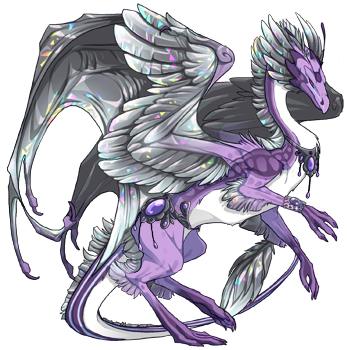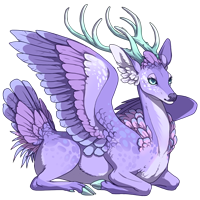

Naarda
(#15412632)
Level 10 Skydancer
Click or tap to view this dragon in Predict Morphology.
Energy: 0/50

Expand the dragon details section.
Collapse the dragon details section.
Personal Style
Apparel



Skin
Scene
Measurements
Length
4.56 m
Wingspan
3.86 m
Weight
631.71 kg
Genetics
Lavender
Skink
Skink
Silver
Facet
Facet
White
Underbelly
Underbelly
Hatchday
Breed
Eye Type
Level 10 Skydancer
EXP: 4990 / 27676






STR
50
AGI
8
DEF
6
QCK
25
INT
5
VIT
12
MND
5
Lineage
Parents
- none
Offspring
- none
Biography

Lavandula (common name LAVENDER) is a genus of 39 known species of flowering plants in the mint family, Lamiaceae. It is native to the Old World and is found from Cape Verde and the Canary Islands, Europe across to northern and eastern Africa, the Mediterranean, southwest Asia to southeast India. Many members of the genus are cultivated extensively in temperate climates as ornamental plants for garden and landscape use, for use as culinary herbs, and also commercially for the extraction of essential oils. The most widely cultivated species, Lavandula angustifolia, is often referred to as lavender, and there is a color named for the shade of the flowers of this species.
Culinary use:
Lavender infused cupcakes
It is grown as a condiment and used in salads and dressings.[18] Flowers yield abundant nectar from which bees make a high-quality honey. Monofloral honey is produced primarily around the Mediterranean, and is marketed worldwide as a premium product. Flowers can be candied and are sometimes used as cake decorations. Lavender flavours baked goods and desserts (it pairs especially well with chocolate), and is also used to make "lavender sugar".[19] Lavender flowers are occasionally blended with black, green, or herbal teas.
Though it has many other traditional uses in southern France, lavender is not used in traditional southern French cooking. It does not appear at all in the best-known compendium of Provençal cooking, J.-B. Reboul's Cuisinière Provençale[20] In the 1970s, a blend of herbs called herbes de Provence which usually includes lavender was invented by spice wholesalers,[21] and lavender has more recently become popular in cooking.
Lavender lends a floral and slightly sweet flavour to most dishes, and is sometimes paired with sheep's-milk and goat's-milk cheeses. For most cooking applications the dried buds, which are also referred to as flowers, are used. Some chefs experiment with the leaves but only the buds contain the essential oil of lavender, from which the scent and flavour of lavender are derived. In the United States, both lavender syrup and dried lavender buds are used to make lavender scones and marshmallows
In history and culture:
The ancient Greeks called the lavender herb nardus, after the Syrian city of Naarda (possibly the modern town of Dohuk, Iraq). It was also commonly called nard.[39] The species originally grown was L. stoechas.[2]
Lavender was one of the holy herbs used in the biblical Temple to prepare the holy essence, and nard ('nerd' in Hebrew) is mentioned in the Song of Solomon (4,14)
nard and saffron,[40]
calamus and cinnamon,
with every kind of incense tree,
with myrrh and aloes,
and all the finest spices.[41]
During Roman times, flowers were sold for 100 denarii per pound, which was about the same as a month's wages for a farm laborer, or fifty haircuts from the local barber. Its late Latin name was lavandārius, from lavanda (things to be washed), from the verb lavāre (to wash).[42]
Click or tap a food type to individually feed this dragon only. The other dragons in your lair will not have their energy replenished.
Feed this dragon Insects.
This dragon doesn't eat Meat.
This dragon doesn't eat Seafood.
Feed this dragon Plants.
Exalting Naarda to the service of the Lightweaver will remove them from your lair forever. They will leave behind a small sum of riches that they have accumulated. This action is irreversible.
Do you wish to continue?
- Names must be longer than 2 characters.
- Names must be no longer than 16 characters.
- Names can only contain letters.
- Names must be no longer than 16 characters.
- Names can only contain letters.










